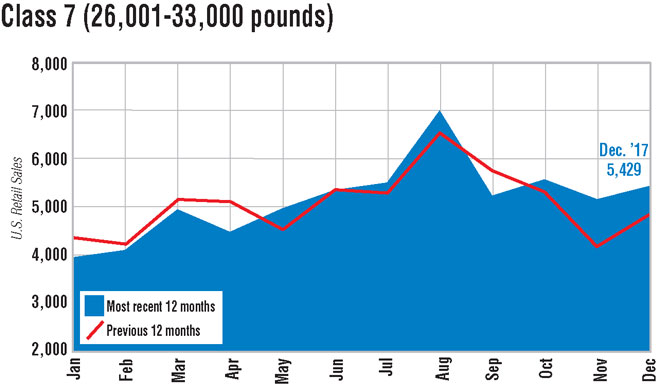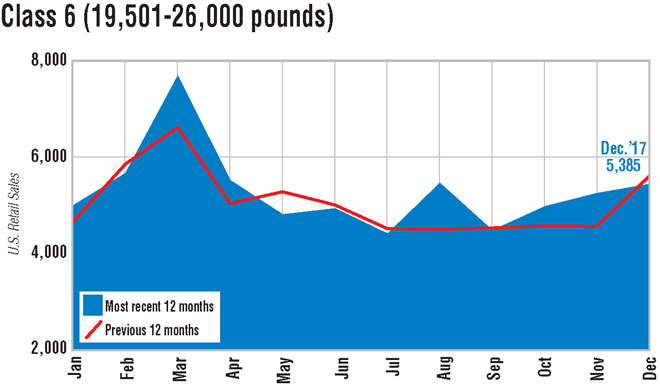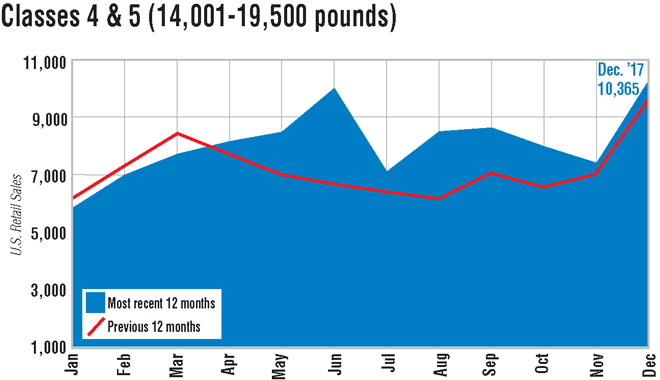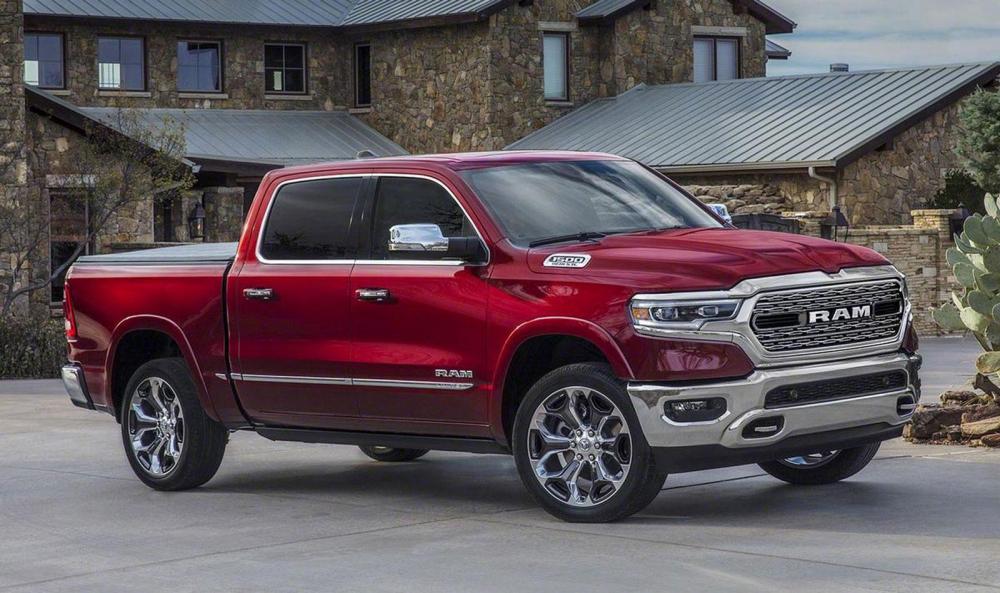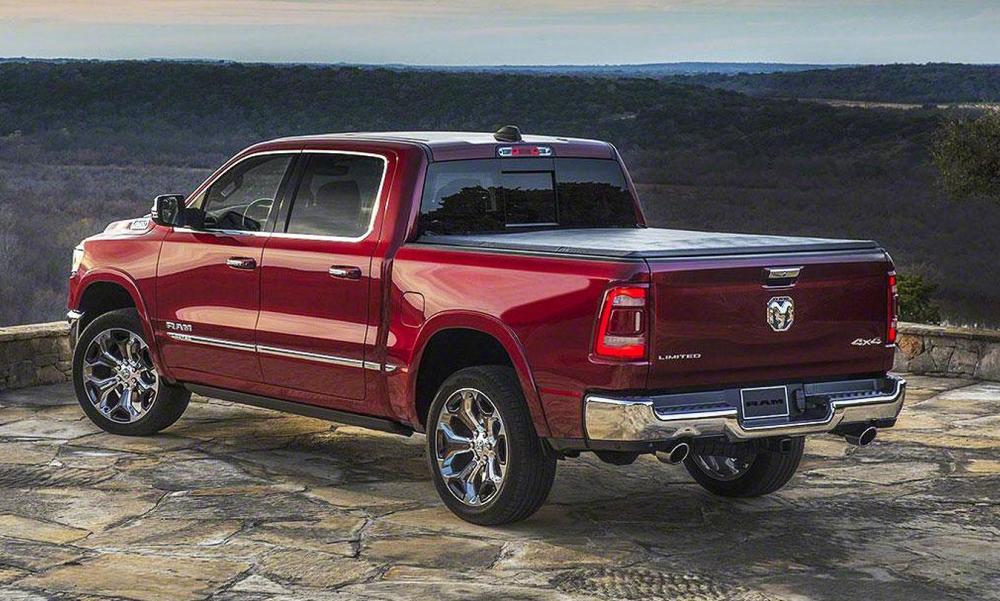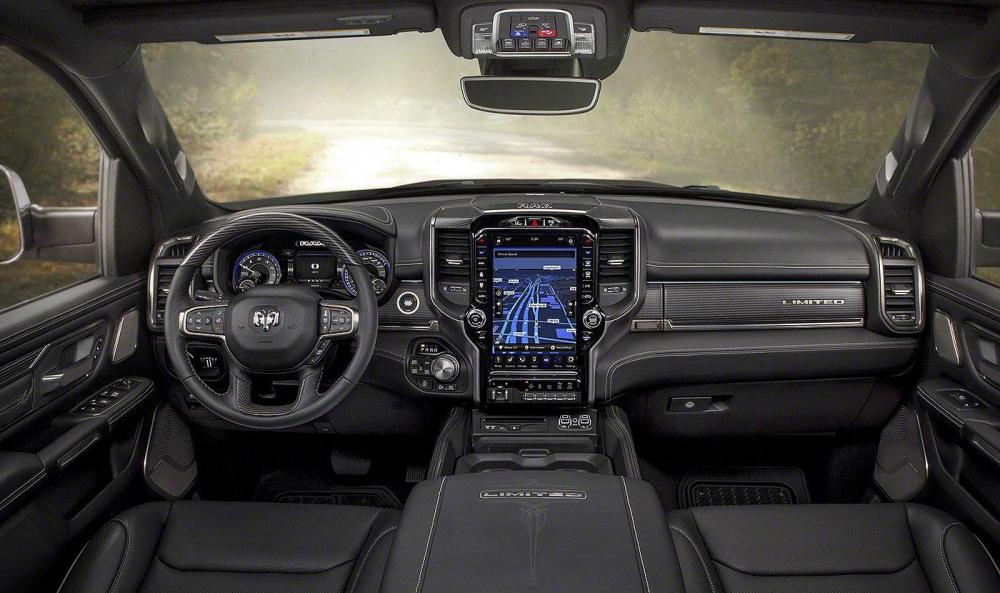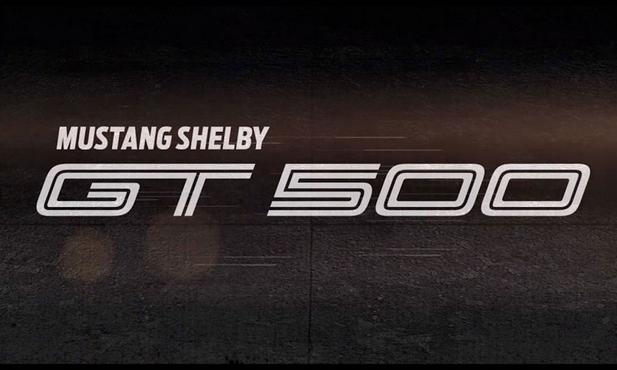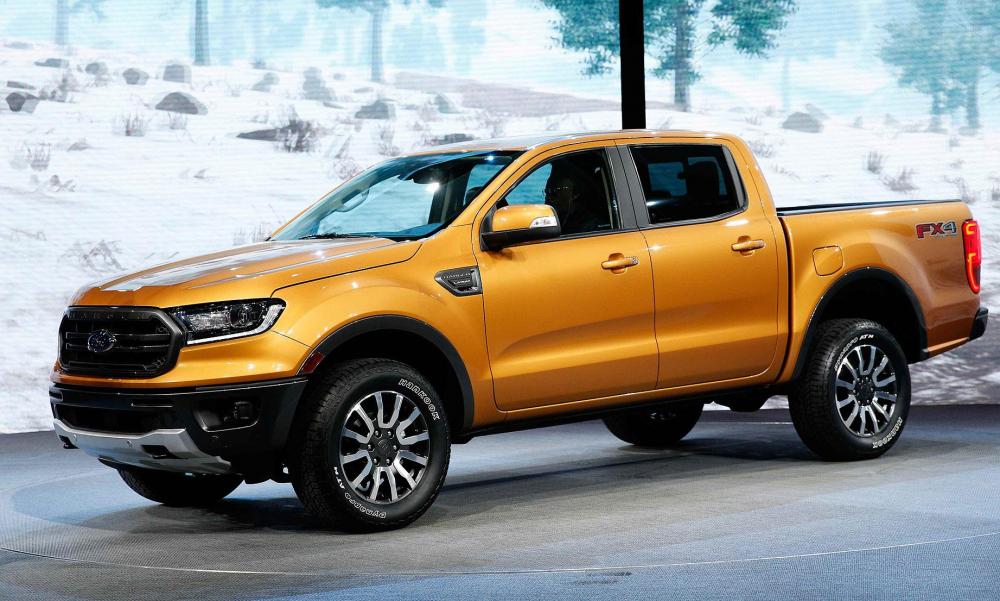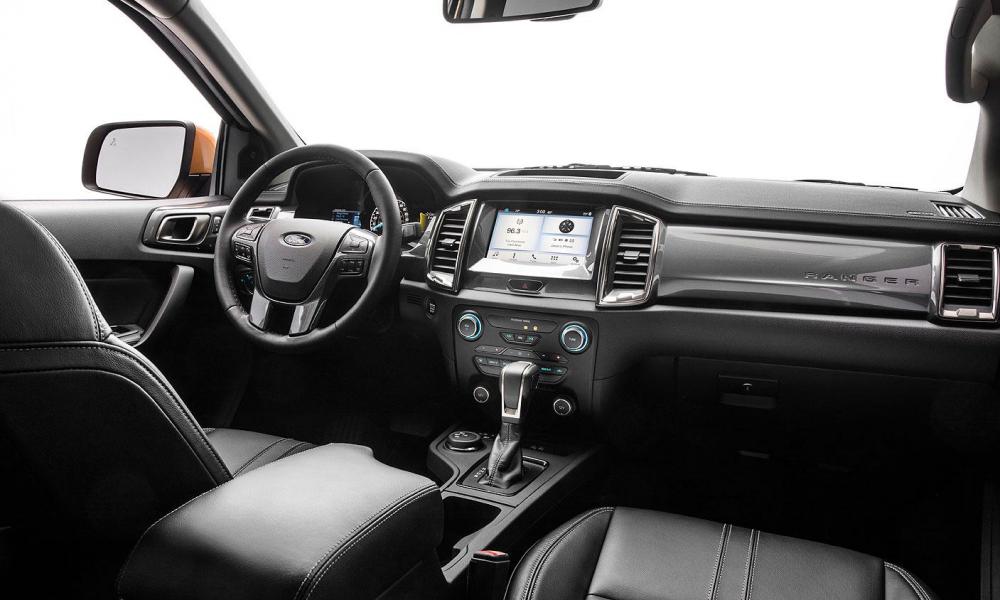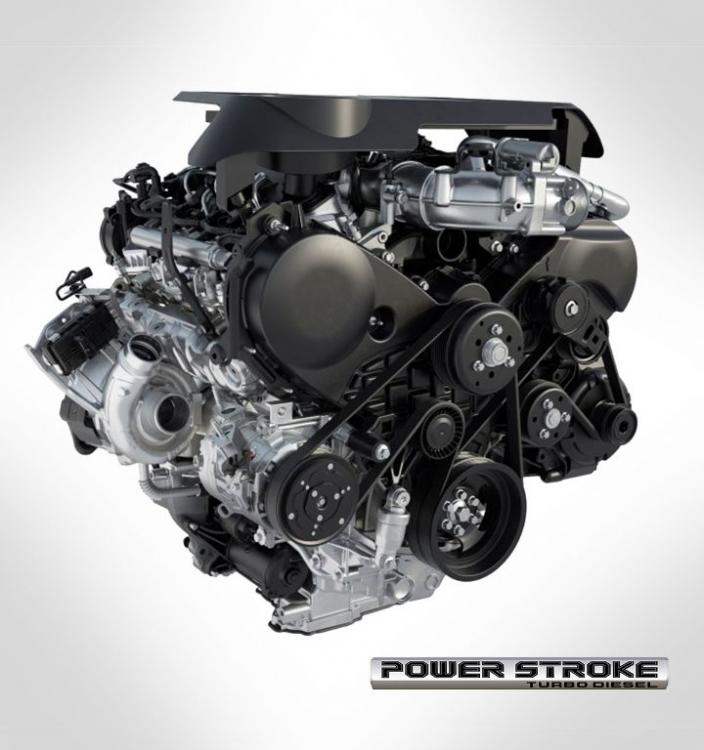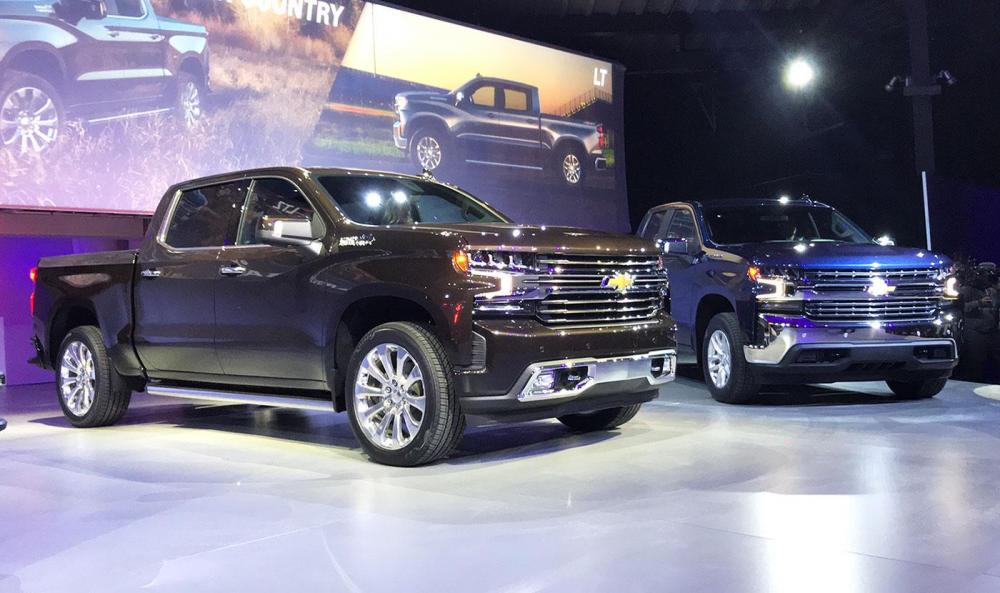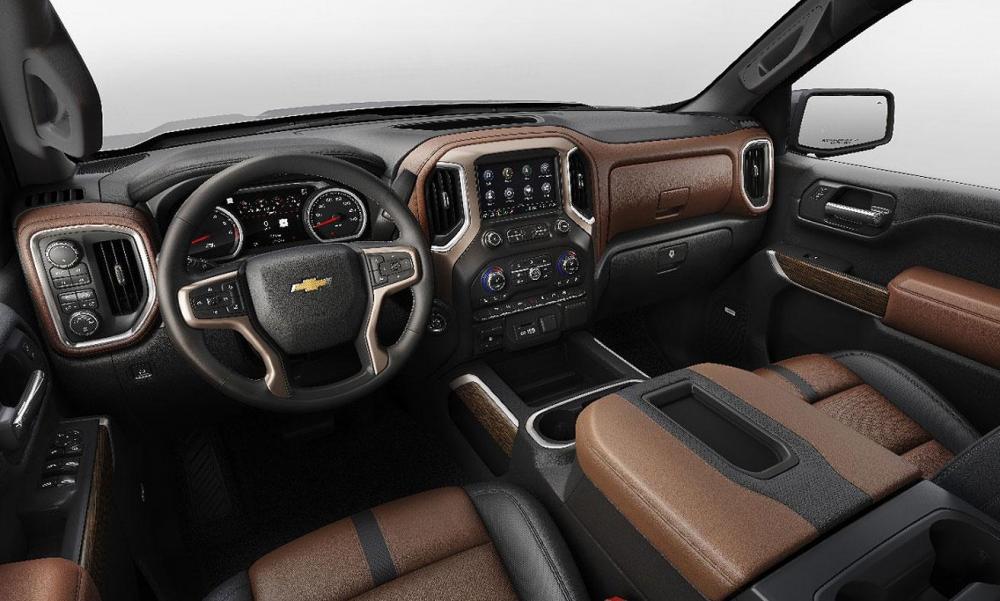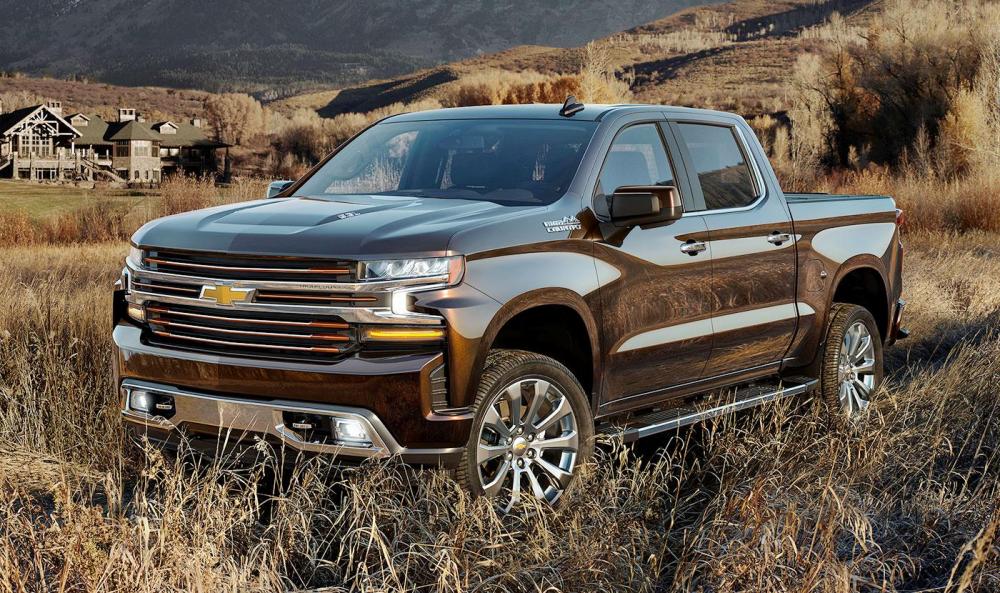
kscarbel2
Moderator-
Posts
17,893 -
Joined
-
Days Won
86
Content Type
Profiles
Forums
Gallery
Events
Blogs
BMT Wiki
Collections
Store
Everything posted by kscarbel2
-
Transport Topics / January 16, 2018 U.S. retail sales of medium-duty trucks climbed 5.4% in December, with only Class 6 volumes dipping from a year earlier, WardsAuto.com reported. Sales of Classes 4-7 trucks totaled 21,179 units compared with 20,096 in the 2016 period. For the full year, sales were 222,790, up 7.3% from 207,694 in the 2016 period. Gains in the period were led by a 13% rise in Classes 4-5. “The growth is not quite as spectacular or as volatile as you see on the Class 8 side [up 43% in December year-over-year], but ever since we came out of the Great Recession [medium-duty] has had a slow methodical, really sustainable, growth rate,” ACT Research Co. Vice President Steve Tam said. “You have investment by businesses, so there are more things being produced, and often it is the medium-duty guys who are at play in that space,” he added. Sales of Class 7 trucks in December jumped 12.9% to 5,429 and were spread among five truck makers. Freightliner led with a 47% market share. Paccar Inc. and Navistar International Corp. were next, while Ford Motor Co. and Hino Motor Sales USA Inc. tied with 264 sales each. Class 6 sales slipped 4.2% to 5,385 in a market crowded with seven truck makers. Segment leader Ford Motor Co. was the main downward force, with sales plummeting 41.5% to 1,685 from 2,883 units a year earlier. Ford did not immediately respond to a request for comment. Freightliner was right behind Ford, selling 1,640 trucks. Others ranked by sales included Hino, Navistar International, Paccar Inc. and Isuzu Commercial Truck of America Inc.. Also in December, GM launched its Chevrolet brand low-cab forward truck in Class 6, selling seven. Classes 4-5 rose 7.3% for the month to 10,365 trucks. Ford led in Class 5 with a 60% market share, or 4,846 trucks. Isuzu earned a 60% share in Class 4 with 1,394 sales. Kenworth Truck Co. announced its K270 Class 6 and K370 Class 7 models now come with the option of the Bendix Wingman Fusion advanced driver assistance system. “There are certainly folks, especially in the private fleets, who understand and are willing to make that kind of an investment in the equipment,” Tam said. Wingman Fusion offers enhanced collision mitigation, lane departure warning, stationary vehicle braking, and overspeed alert and action. .
-
FCA lavishes tech, safety gear on 2019 Ram pickup Larry Vellequette, Automotive News / January 15, 2018 DETROIT -- When FCA US abandoned mainstream compact and midsize sedans in 2016 to focus its limited resources on more profitable utility vehicles and pickups, analysts viewed the shift from cars as risky. But the redesigned 2019 Ram 1500 -- bowing Monday at the Detroit auto show -- appears to be a major beneficiary of the strategy, sporting a long list of engineering, safety, performance and functional improvements. The Ram pickup is the automaker's best-selling vehicle and the third-best-selling vehicle in the U.S. behind the Ford F series and Chevrolet Silverado. Even as it nears the end of its current product cycle, the outgoing Ram managed to chalk up a U.S. sales gain in 2017, topping 500,000 for the first time ever, including the decades when the Ram was part of the Dodge brand. With the redesigned Ram 1500 going into production this month -- along with the previous model, which will continue to be produced for up to a year -- FCA officials believe the Ram has a shot to knock the Silverado out of second place. Chevrolet plans a major redesign of the Silverado that is also on display in Detroit and will hit showrooms in the fall. But the new Ram bows in showrooms in the first half of 2017, giving FCA a chance to narrow GM's 85,000 unit sales lead with both a new and outgoing Ram. The 2019 Ram 1500 is bigger than the previous model, with overall length growing by 9 inches, including 4 additional inches to the cab. The added cab space enables the second-row seats to recline up to 8 degrees. The redesigned pickup is also stronger than the previous version. The frame is made of 98 percent high-strength steel. Also, a new eTorque mild-hybrid system increases torque by 90 pound-feet on the 3.6-liter V-6 engine, and by 130 pound-feet on the 5.7-liter V-8 engine. The eight-speed automatic transmission has also been improved. Maximum payload increases to 2,200 pounds and maximum trailer towing to 12,700 pounds. The 2019 Ram also boasts increased efficiency. A belt-drive generator and 48-volt battery are standard, as are short-term torque assist and regenerative braking. Drag coefficient improves to .357, with active grille shutters, raised bed rails, an air dam and air suspension contributing to a more aerodynamic ride. Fuel economy numbers were not yet available, however, and FCA has not yet indicated whether it will keep its 3.0-liter EcoDiesel engine as an option for the 2019 pickup. Even though it is longer, wider and taller than the previous Ram 1500, engineers were able to trim nearly 225 pounds from the latest model. Inside the cabin, legroom is increased in the first and second rows, while the reclining second-row seating has new folding center armrests. A new 12-inch infotainment touch screen dominates the instrument panel, with split-screen capabilities allowing simultaneous operation of up to two functions, such as the climate controls and navigation. A bird's-eye camera system eases parking, and the pickup gets Sirius XM's new 360L service that allows individualized streaming for subscribers. A 19-speaker, 900-watt Harman Kardon audio system with repositioned door speakers to improve sound quality is optional. Interior storage space is greatly expanded, including a larger reconfigurable center console that can be transformed into 12 storage combinations. The optional RamBox bed storage boxes include a three-prong 115-volt plug. The 2019 Ram 1500 will continue to be powered by the 305-hp 3.6-liter V6 engine or an optional 5.7-liter Hemi V-8. But engineers were able to quiet the cabin in the V-8 model by employing frame-mounted "active tuned mass modules," which work electronically to dampen engine noise in the cabin, reducing cabin noise to 67 decibels. Both engines are paired with an updated version of its eight-speed automatic transmission. In terms of safety, Ram incorporated new wheel blockers into its frame across all trim levels to improve performance in slight offset frontal crash tests. In addition to expected electronic safety features such as automatic braking and adaptive cruise control, the Ram 1500 will have available adaptive front lighting that illuminates up to an additional 15 degrees in the direction of travel. Pricing has not been announced. Production of vehicles for sale will begin this month. The previous-generation 2018 Ram 1500 will remain in production for "at least a year," FCA CEO Sergio Marchionne said in October, in part to help guard the new pickup's residual values. . .
-
Where's Chevy's mid-engine Corvette? Richard Truett, Automotive News / January 16, 2018 One of the most talked-about cars leading up to press days at the North American International Auto Show this week isn't even at the show. In fact, it has not even been confirmed by its manufacturer, General Motors. We're talking about the next-generation Chevrolet Corvette, widely expected to have its engine placed behind the seats for the first time in its 65-year history. Enthusiast car magazines and websites have been breathlessly reporting that the eighth-generation Corvette would make its long-awaited debut this week in Detroit. Turns out it was premature speculation. Although the car has been caught testing numerous times by spy photographers, and appears nearly fully baked, apparently no one outside GM knows when it will debut. The next major global auto show happens in early March in Geneva and nearly all the world's supercar manufacturers are on this year's list of exhibitors. GM and Chevrolet are not scheduled to attend -- but that may be a ruse to tamp down speculation. If you are going to launch a bona fide American supercar, why not take it to the Europeans and introduce it in their backyard? Also, even though GM no longer owns Opel and Vauxhall, Chevrolet maintains a small presence in Europe, offering Camaro and Corvette in several countries. So a European launch for the Corvette is plausible. Last week, I thought there was a decent chance Chevrolet would roll out the next-gen Corvette at the Detroit show. The redesigned Silverado pickup had its coming-out party at a weekend press event, clearing the way, I thought, for the next-gen Corvette to suck the oxygen out of Cobo Center just like the Ford GT did in 2015. It didn't happen. Several people I know who claim to have good sources in GM say the car will be shown next year at the Detroit show. I hope not. With more and better spy shots coming almost weekly, there won't be much mystery left to the new car. Photo gallery - http://www.autonews.com/apps/pbcs.dll/gallery?Site=CA&Date=20180105&Category=PHOTOS01&ArtNo=105009999&Ref=PH&Profile=1115
-
Ford to hatch most powerful street-legal Mustang under Shelby badge Michael Martinez, Automotive News / January 15, 2018 DETROIT -- Ford Motor Co. next year will launch its most powerful street-legal Mustang ever: a 700+ hp Shelby GT500. Joe Hinrichs, head of Ford's global operations, teased the high-performance pony car at the 2018 Detroit auto show on Monday. Ford showed a short teaser video showing brief glimpses of a red Mustang accompanied by the Shelby's signature Cobra badging. No other details were released. The Shelby GT500 will mark one of 12 new performance vehicles that Ford has vowed to bring to market by the end of the decade. . .
-
Chevrolet forges sleeker, aerodynamic styling on 2019 Silverado
kscarbel2 replied to kscarbel2's topic in Odds and Ends
GM picks Mich. plant to build new Silverado diesel engine Richard Truett/Michael Wayland, Automotive News / January 16, 2018 DETROIT -- The new 3.0-liter turbodiesel engine coming in the redesigned 2019 Chevrolet Silverado will be manufactured in a General Motors engine plant in Flint, Mich. Production of the engine -- designed at the General Motors diesel center of excellence in Turin [Italy] -- will start late this year or early next year. It was unclear how many new jobs could be created by the move. GM Vice President of Global Propulsion Systems Dan Nicholson would not divulge technical details of the new fuel-efficient engine, but he confirmed that the Flint engine plant would be the production site. Over the weekend, at the press debut of the new pickup, GM product chief Mark Reuss said Flint would play a "very important" role in the "long-term viability" of the pickup. He declined to offer any specifics. "You're going to see some announcements around Flint," he said after unveiling the Silverado on Saturday in Detroit. Flint Assembly produces regular and crew cab heavy-duty models of the Silverado and GMC Sierra. The diesel engine, combined with a weight reduction of 450 pounds and a new, fuel-efficient 10-speed automatic transmission, is widely expected raise the Silverado's fuel economy to 30 mpg or more on the highway -- which would meet or beat the diesel-powered Ford F-150 debuting this year. It also would give GM an industry-leading two trucks with highway fuel economy in the 30s. The diesel-powered Chevrolet Colorado and GMC Canyon have EPA-certified fuel economy of 30 mpg. The 3.0-liter engine is the first light-duty diesel available in a full-size GM pickup since the mid-1990s. Nicholson said the new engine is an all-new GM design -
Trump and Immigration (Illegal Immigrants in the US)
kscarbel2 replied to kscarbel2's topic in Odds and Ends
“This will provide an unprecedented level of protection for Illinois’ half-million" illegal immigrants, said public servant Illinois Governor Bruce Rauner. -
Can Ranger crash GM's midsize pickup party? Michael Martinez, Automotive News / January 15, 2017 DETROIT — If General Motors struck gold by reviving the Colorado and Canyon midsize pickups four years ago, then Ford had better hope that mine isn't tapped out by the time the Ranger reaches dealerships early next year. The segment exploded in popularity this decade — it has surged 78 percent since 2014 — but that growth appears to be running out of steam. Last year's U.S. sales of 452,335 midsize pickups were less than 1 percent more than the year prior, and IHS Markit doesn't expect the segment to top 480,000 sales through 2025. "Ford is late to the party," Michelle Krebs, senior analyst for Autotrader, said in an interview. "The question is: Is there room for yet another entry, or has the growth in that segment peaked? It's quite possible that it has." Still, Ford believes next year is the right time to resurrect the Ranger nameplate, which was discontinued for U.S. buyers in 2011 while remaining in many global markets. Officials are positioning the pickup as a lifestyle vehicle that appeals to younger, active buyers who may not want the herculean hauling capabilities — and higher price tag — of a full-size F-150. "It's really just not about growth and the segment size itself; it's about some of the dynamics that are happening within full-size," Todd Eckert, Ford's truck marketing manager, told reporters this month. "As transaction prices continue to grow, we see more of an opportunity than we did, say, five years ago, to bring in a midsize pickup ... and really get to that entry-level buyer, who's a very different customer." The Ranger, which Ford planned to unveil Sunday, Jan. 14, at the Detroit auto show, will differ significantly from the F-150. It has a mostly steel body, eschewing the aluminum diet the F series, Expedition and Lincoln Navigator have undergone. Instead of the multitude of powertrain options on the F-150, the Ranger will come with one: a 2.3-liter EcoBoost engine mated to a 10-speed automatic transmission. It includes rugged front and rear differentials from Dana Inc., which also supplies the Jeep Wrangler. An available electronic-locking rear differential should give the vehicle better off-road maneuverability than its bigger brother. "These buyers have a work/play lifestyle that requires something of a different scale," Eckert said. Architecturally, the Ranger will differ little from the version sold outside the U.S., but it will be built in Michigan with parts sourced in North America. Interior and exterior designs have been changed to give the truck a more rugged look for U.S. buyers. "This is not about bringing the global Ranger here to the U.S. and selling it in our dealerships," Eckert said. "This is about designing and engineering specifically for the North American customer and the conditions the trucks will be put in here." It will have lots of new technology, such as a standard 4G connected Wi-Fi hotspot, FordPass and precollision assist, as well as other optional driver-assist features. It will come in three trim levels: XL, XLT and Lariat. Ford will sell two-door SuperCab and four-door SuperCrew configurations. An off-road FX4 package will be offered across all trims. That will give drivers the terrain-management system first offered on the F-150 Raptor that includes four drive modes: normal, grass/gravel/snow, mud/ruts, and sand. The package also includes a new "trail control," which acts as an off-road cruise control by accelerating or braking to maintain a set speed while traversing gravel or mountain trails. It's an extension of the automaker's hill-descent control, which controls braking on steep grades. The FX4 package will also come with standard automatic emergency braking. The Ranger also will have a blind-spot information system with sensors that can extend their line of sight to the back of a trailer up to 33 feet long. The system will be standard on the XLT and Lariat trims. The interior includes an 8-inch touch screen, as well as two liquid crystal display screens in the instrument cluster. The rear seats offer waterproof underseat storage. Ford said it expects the Ranger to have best-in-class payload capacity but declined to give details on power, fuel economy, dimensions or weight. The company hopes to recapture some of the midsize pickup buyers it abandoned when it closed the St. Paul, Minn., plant that built the previous-generation Ranger. It also aims to conquest from other brands, woo some F-150 buyers — though not too many, and only if they otherwise would have defected to a rival brand — and even snatch sales from small crossover and sedan buyers. It wants the Ranger to add to its strong overall pickup sales; its full-size F series has been the nation's best-selling pickup for 41 straight years. "We see an opportunity," Eckert said. "It's one thing to get on top, but it's also about staying on top."
-
One for kscarbel2
kscarbel2 replied to Swishy's topic in Antique and Classic Mack Trucks General Discussion
Thank you Ted. I know the author, Steve Brooks. I told him that he's the best heavy truck journalist in the business. -
Trump and Immigration (Illegal Immigrants in the US)
kscarbel2 replied to kscarbel2's topic in Odds and Ends
We have laws that are rigidly enforced.........and then we have laws which are not enforced. It sends a bad message. Not a good way to run a ship. If foreigners are only allowed, by law, to legally immigrate to the United States, then one would be sure that all "illegal" immigrants are detained and immediately deported (and denied the ability to legally immigrate, as a penalty, for a period of time if not forever). No child born to illegal immigrants should be granted citizenship (i.e. DACA). If they want to complain, they should address their parents. The U.S. has nothing to do with it. The current system is, if you were able to sneak in and not be captured for a period of time, you can stay. That doesn't fly with me. -
I suggest, the demand for a manual transmission option in the Ranger segment is entirely different from the F-150 segment. The biggest deal breaker is the lack of the 2.2L 4-cylinder diesel and 3.2L 5-cylinder diesel (known to Americans by way of the U.S. market full-size Transit). That the truck has but one engine, in North America, is shocking. The fact that it isn't available with the standard cab and long bed means they don't care about the commercial segment. I was planning to purchase a US market diesel Ranger and Everest in the 2019-2020 period (whenever they launched). WIthout the diesel option, that plan is firmly cancelled.
-
No diesel option and no manual transmission. Bob, as predicted, Ford ruined the global Ranger for the US market. I'm a U.S. buyer, and this truck was not "developed specifically" for me. "This is not about bringing the global Ranger here to the U.S. and selling it in our dealerships," said Todd Eckert, Ford trucks marketing manager. "This is about designing and engineering specifically for the North American customer and the conditions the trucks will be put in here." Mr. Eckert, you should have brought over the global Ranger. You completely don't understand this product, nor the US market for it.
-
Ford Ranger (finally) returns to US market Michael Martinez, Automotive News / January 14, 2018 Ford aims Ranger at pickup buyers who want smaller, simpler package DETROIT -- After an eight-year hiatus, Ford Motor Co. is re-entering the midsize pickup segment with the 2019 Ford Ranger, which offers truck buyers some of the features and benefits they could get in an F-150 but with fewer customization options, a smaller footprint and lower price tag. The revived Ranger, which will be made in Michigan and go on sale next year, has a similar architecture to the pickup Ford sells in dozens of markets overseas, but its design and powertrain have been developed specifically for U.S. buyers. Ford, which plans to formally introduce the Ranger at the Detroit auto show on Sunday, will offer only one engine option: a 2.3-liter EcoBoost mated to a 10-speed automatic transmission. The latest Ranger has a mostly steel body, rugged axles from Dana Inc. and an exterior design similar to its larger F-series counterparts. During development, it went through the same torture tests as the F-150. "This is not about bringing the global Ranger here to the U.S. and selling it in our dealerships," said Todd Eckert, Ford trucks marketing manager. "This is about designing and engineering specifically for the North American customer and the conditions the trucks will be put in here." The Ranger will include a host of new technology, such as a standard 4G-connected Wi-Fi hot spot, FordPass Connect and pre-collision assist technology as well as a number of other optional driver-assist features. It will come in three trim levels: XL, XLT and Lariat. Ford will sell two-door SuperCab and four-door SuperCrew configurations. An off-road FX4 package will be offered across all trims. That will give drivers the terrain-management system first offered on the F-150 Raptor that includes four drive modes: normal, grass/gravel/snow, mud/ruts and sand. The package also includes a new "trail control," which acts as an off-road cruise control by accelerating or braking to maintain a set speed while traversing gravel or mountain trails. It's an extension of the automaker's hill-descent control, which controls braking on steep grades. The FX4 package will come with standard automatic emergency braking. The Ranger also will have a blind-spot information system with sensors that can extend their line of sight to the back of a trailer up to 33 feet long. The system will be standard on the XLT and Lariat trims. The exterior will include frame-mounted steel bumpers as well as the Ranger's name prominently stamped into the tailgate and some grille designs. The interior includes an 8-inch touch screen as well as two LCD screens in the instrument cluster. The rear seats offer waterproof underseat storage. Ford said it expects the Ranger to have best-in-class payload capacity but wouldn't divulge any details on power, fuel economy, dimensions or weight. While the U.S. midsize pickup market peaked years ago -- at 1.32 million in 1986 -- it has staged a modest rally in recent years, yet remains small, with the introduction of revived models from General Motors. U.S. sales in the segment haven't topped 1 million since 2000 or 500,000 since 2007. The Ranger was always among the segment's top sellers, including No. 1 as recently as 2004. During the 1990s, Ranger sales routinely totaled more than 300,000 units a year before fading in the 2000s. Ford hopes to recapture some of the midsize pickup buyers it abandoned when it closed the St. Paul, Minn., plant that built the previous-generation Ranger. It also aims to conquest from other brands, woo some F-150 buyers — though not too many, and only if they otherwise would have defected to a rival brand — and even snatch sales from small crossovers and sedans. It wants the Ranger to add to its strong overall pickup sales; the full-size F series has been the nation's best-selling pickup for 41 straight years. "We see an opportunity," Eckert said. "It's one thing to get on top, but it's also about staying on top." Photo gallery - http://www.autonews.com/apps/pbcs.dll/gallery?Site=CA&Date=20180114&Category=DETROIT_AUTO_SHOW&ArtNo=114009999&Ref=PH&Profile=1115 .
-
The arrival of the Transit Custom (panel van) and sister Transit Tourneo (window van) is long overdue. But they would have had to add the US market-specific engine fire feature. https://www.bigmacktrucks.com/topic/47453-new-man-tge-and-volkswagen-crafter-launched-at-iaa-2016/?tab=comments#comment-350078
-
Chevrolet forges sleeker, aerodynamic styling on 2019 Silverado
kscarbel2 replied to kscarbel2's topic in Odds and Ends
http://media.chevrolet.com/media/us/en/chevrolet/home.detail.html/content/Pages/news/us/en/2018/jan/0113-2019-silverado.html -
Jay Leno's Garage - 1953 Firebird I and 1958 Firebird III
kscarbel2 replied to kscarbel2's topic in Odds and Ends
. . -
GM executives defend NAFTA, Mexican truck plant David Shepardson, Reuters / January 13, 2018 DETROIT -- General Motors CEO Mary Barra expressed optimism on Saturday that the North American Free Trade Agreement would survive, and other senior GM executives stood by the company's plans to continue building trucks in Mexico. At an event to introduce GM's 2019 Chevrolet Silverado pickup truck ahead of the Detroit auto show, Barra twice did not answer directly when asked if the automaker is reconsidering current production in Mexico in light of potential changes or the collapse of the trade deal between the United States, Canada and Mexico. Company executives did not rule out future changes to its North American production plans depending on the outcome of ongoing NAFTA renegotiation talks, even though it would be costly to shift production of trucks. Fiat Chrysler Automobiles NV said on Thursday it will move production of its next-generation heavy-duty pickup trucks to Michigan from a plant in Mexico, a move that reduces the risk that those trucks would be hit with a 25 percent tariff if NAFTA unravels. Barra sidestepped a question about GM's Mexican truck factory, saying, "When I look at our footprint, there is so much more work and negotiations to be done on NAFTA." Mark Reuss, GM's product development chief, said the company is using its existing truck plants in North America, but would not elaborate when asked if GM could stop building trucks in Mexico. "I'm not sure that we would tell anybody that," Reuss said. "I don't think we'd be talking about our footprint in the future."
-
The New 3.0L Power Stroke Turbo Diesel V6 https://www.ford.com/trucks/f150/?gclid=EAIaIQobChMIu7WClcTW2AIVgeNkCh2F4wXpEAAYASAAEgKdVPD_BwE&searchid=757864977|39397447585|283121643333|&s_kwcid=AL!2519!3!244250334842!e!!g!!f 150 diesel specs&ef_id=WlbF0gAAA_YBFRGW:20180114034047:s#the_new_3.0l_power_strokeR_turbo_diesel .
-
Chevrolet forges sleeker, aerodynamic styling on 2019 Silverado
kscarbel2 replied to kscarbel2's topic in Odds and Ends
'19 Silverado may emerge as efficiency leader Michael Wayland, Automotive News / January 13, 2018 DETROIT -- Industry-first engine technology, significant weight savings and a new inline-six diesel offering are among the enhancements General Motors is counting on to bolster the Chevrolet Silverado's position as the second-best-selling vehicle in America. The redesigned 2019 model, shown Saturday evening ahead of the Detroit auto show, is larger than current models yet as much as 450 pounds lighter. It features a longer wheelbase, more interior space and a new high-strength steel bed with increased cargo volume and an available power up-down tailgate that can be operated from the key fob, an interior button or by hand. 2019 Chevy Silverado · Interior · - Up to 8-in. touch screen · - Increased front and rear room · - Concealed rear-seat storage areas · Design/engineering · - 3.9 in. longer · - Up to 450-lb. weight reduction · - Next-gen cylinder-cutoff technology · - Optional 3.0-liter I-6 turbodiesel · - Available 10-speed transmission · - Redesigned suspension to improve steering/braking · - Power tailgate, up and down The enhancements and weight reduction could help the 2019 Silverado stake a claim as the most efficient full-size pickup in the market when it arrives in dealer showrooms in fall. GM product boss Mark Reuss called the redesign a “massive undertaking” that resulted in a “very responsive” truck that’s larger, lighter and more durable than ever before. “We are confident that the Silverado will be the very best truck for every customer,” he said Saturday following the unveiling of the trucks here. GM will offer six powertrain combinations, including a 3.0-liter inline-six diesel and 5.3- and 6.2-liter V-8s with a technology called Dynamic Fuel Management that can shut off cylinders, in a variety of combinations, to optimize performance and fuel economy. It's expected to increase efficiency by as much as 21 percent, though GM didn't give details. “It’s revolutionary,” Reuss said of the industry-first technology. “It’s like nothing we’ve ever seen before in terms of how many cylinders you can have at any one time in any one different condition.” The diesel engine -- the first in a full-size Chevy pickup since the late 1990s -- and 6.2-liter V-8 will be mated to a 10-speed automatic transmission. GM didn't provide details of other transmission pairings or engines. Chevy currently offers a 4.3-liter V-6 as its base engine. The redesigned pickup will have six engine options. The base engine, Reuss said, could “quite possibly” be a new offering. He declined to comment on whether it will be a four-cylinder engine. On the diesel, he said: "I am really confident that we will have the best-performing diesel in the segment." Ford Motor Co. earlier this week announced that it expects its first diesel F-150, which goes on sale this year, to achieve a highway fuel economy rating of 30 mpg. The eight trim levels include two new Z71 Trailboss models and an RST, for Rally Sport Truck, trim. The models will be much more distinctive than the Silverado's current offerings, said Sandor Piszar, Chevrolet truck marketing director. "We wanted to make it easier for consumers and dealers to find the right truck for what they're looking for, and we've further refined that notion," he told Automotive News, adding that consumers and dealers can expect a "similar price walk" to the current pickups. Pricing, fuel economy and other details have yet to be announced. During Saturday's event, GM product boss Mark Reuss called the redesign a “massive undertaking” that resulted in a “very responsive” truck that’s larger, lighter and more durable than ever before. “We are confident that the Silverado will be the very best truck for every customer,” he said. Production starts Production of the Silverado and the forthcoming redesigned GMC Sierra is expected to start at GM's plant in Fort Wayne, Ind., in the fall. GM also builds the trucks in Mexico. Reuss said the Fort Wayne plant will add production of the crew-cab models, which have been built only in Mexico. GM reportedly spent nearly $3 billion on updating its factories for its next-generation trucks in ways that allowed for streamlined manufacturing, fewer parts and lighter trucks. "This is a ground-up, all-new way of looking at a pickup from manufacturing, from design, from everything," said Tim Herrick, executive chief engineer of full-size trucks. "Every model got some level of weight savings, up to 450 pounds." Much of the weight savings came from the pickup's frame and body. All exterior swing panels (doors, hood and tailgate) are made of aluminum, while fixed panels (fenders, roof and bed) are made of steel. Eighty percent of the frame is made of high-strength steel, 2 to 5 millimeters thick. GMC Sierra The Silverado and Sierra, according to Reuss, will arrive in showrooms at the same time later this year. He said GM plans to unveil the Sierra toward the end of the first quarter or the beginning of the second quarter. GM hasn’t unveiled the pickups separately since the first-generation Silverado debuted as part of a rodeo-themed news conference in 1998. . -
Hino's new US market COE is based on the Class 5/6/7 500 series. It's no Class 8 by any means. The GM-Navistar product is Classes 4 and 5. The DuraStar replacement is Classes 6 and 7. GM is venturing back into Class 6 with the 6500XD, derived from Isuzu's FTR. All rather convoluted, but the result of GM wanting to get back into the game without spending any serious money. http://www.chevrolet.com/commercial/low-cab-forward-cab-over-truck https://www.gmfleet.com/chevrolet/low-cab-forward-trucks.html
-
The launch of the US market 500 Series COE is overdue. They've been talking about its launch for some time. That segment is about to become very crowded. The US market conventionals have a 500 Series-based cab. The 700 Series heavy truck range has a larger cab (which is to say that the 300, 500 and 700 Series trucks each have unique purpose-designed cabs). http://www.hino-global.com/content/dam/hino_global/pdf/catalog/HINO300_Series__Catalog_Right_Hand_Drive.pdf http://www.hino-global.com/content/dam/hino_global/pdf/catalog/Hino_500S_Catalog_LR.pdf http://www.hino-global.com/content/dam/hino_global/common/img/product/Hino_700S_Catalog_201607.pdf
BigMackTrucks.com
BigMackTrucks.com is a support forum for antique, classic and modern Mack Trucks! The forum is owned and maintained by Watt's Truck Center, Inc. an independent, full service Mack dealer. The forums are not affiliated with Mack Trucks, Inc.
Our Vendors and Advertisers
Thank you for your support!


